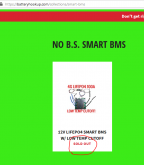PfloydBham
New Member
- Joined
- Dec 27, 2019
- Messages
- 54
Where do you get the 3/8" and larger terminal rings to attach to the BMS leads? those wires are tee-9-cee! Most of the copper rings i run across are for 10 awg and thicker. I am installing one of the "hookup" BMS's on a Al case prismatic 100 amp battery (Orient Power) and right now I am just winding the lead around the terminal since that seems to work for now.
Thanks,
Pink
Thanks,
Pink



